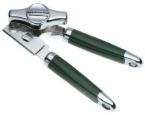Can opener

|
Warning! This article has just been infected with the deadly Crappy Template Virus. Please feel free to run round like a maniac, pray to a deity of your choice and beg for mercy. Have a nice day! |
| This article documents an event that you have missed. You may have to time travel to experience it. |
| Can Opener | |
|---|---|
| Scientific classification | |
| Kingdom | Culinae |
| Phylum | Instrumentum |
| Class | Incisum |
| Order | Cibarium |
| Family | Lamina |
| Genus | Calathus |
| Species | Perutilis Perutilis |
| Binomial name | |
| Tin Opener | |
| Specifications | |
| Primary armament | Steel cutting edge |
| Secondary armament | Gear wheel |
| Power supply | Human, with some experiments with steam circa 1800 |
| Health | A pleasant condiment which unfortunately comes in bottles, not cans |
| Mana | None. Not even a little tiny one |
| Strength | High quality steel |
| Intelligence | Very unreliable. I mean, everybody knows that they sexed up that dossier... |
| Weight | Getting a bit personal now, aren't we? |
| Length | I couldn't possibly comment, can openers are notoriously shy about these things |
| Special attack | Leaving the edge of the lid really sharp so that you slice your hand open on it when you pick it to to put it in the bin |
| Conservation status | |
| Low risk, slowly being overtaken by the electric can opener, a separate species | |
A Brief History Of The Can Opener[edit]
Origins[edit]
The earliest reference to the can opener can be found in the writings of the Ancient Greek historian Herodotus (484 BC-c.a. 425 BC) whilst he was visiting Ancient Egypt:-
- "When visiting the temple of Luxor I was astounded to see the most unusual relief carved into one of the more dilapidated columns. The guide told me that the relief showed that the god Seth was envious of the claws of the desert scorpion which could cut through the armour of any prey. After some brief thought he took up some clay, mixed it with his spittle and crafted a set of rudimentary pincers for himself. He spent much of his time toying with his new limbs; cutting down trees, decapitating livestock, threatening old ladies and the like for three whole days."
- "However, on the morning of the fourth day, feeling passionate, the god Seth went to embrace his wife, the goddess Nephthys. His huge and clumsy pincers sliced his wife into pieces in an instant. The god Seth then tore the claws from his arms and smashed them on the ground. He then, with a heavy heart, proceeded to get out the Bostik that he had borrowed from the god Anubis and reassemble his wife in the hope that he could ressurrect her before the Viagra wore off".
As a result of this legend, imitation pincers crafted from bronze became highly popular items of kitchenware and were frequently sold in flea markets and given away as prizes at carnivals during the Middle Kingdom (2030 BC-1640 BC) era of Ancient Egypt. However, they soon fell out of favour with higher society as a result of their limited practicality (recorded uses included opening sarcophagi, skinning crocodiles, as an offensive weapon in armed robberies, personal groomers, cattle prods and back scratchers) and became an obscure novelty item.
Rediscovery[edit]
It was not until the outbreak of the Hundred Years War (1337 AD-1453 AD) around one and a half thousand years later that the can opener and all of its many applications were rediscovered by a group of English Naval officers on shore leave in Alexandria. The officers discovered the original blueprints for the "Egyptian Proto-Arachnid Outer Layer Remover" in a back-street curiosity shop whilst on a drunken binge.
However one of the more astute of the officers; one Lt. William "I Hate Burgundians" Pritchard to be precise, immediately realised the can-opener's potential as a military device and sent the plans the King Edward the Second of England (1284 AD-1327 AD). Pleased with this new discovery, he sent the blueprint to his Ye Olde Militarye Weapons Developmente Council who applied the new device as a variant to the standard infantry issue pole-axe.
This new device (named "Ye Olde Froge Skeweringe Device") was designed to remove the armour of French knights. The only major design alteration was the removal of one half of the pincers, meaning that this new device more closely resembled a modern hand-operated can opener (as opposed to the more modern rotary can opener). Having vastly evened up the odds for the English peasant infantry, the device was soon universally adopted as the infantry weapon of choice throughout the Middle Ages. However, the discovery of gunpowder and the subsequent adoption of firearms by the world's military and the subsequent decline of armoured heavy cavalry once again threatened to cast the can opener into obscurity.
The Dawn Of A New Age[edit]
As the result of the military abandoning the use of the can-opener during the 14th century, masses of them were now available cheaply to civilians from scrap merchants and army surplus stores. Whilst they sold well initially as knives, cleavers, wood-axes etc, it became clear that the can-opener had greater potential than was being officially recognised at the time. However, all attempts to modernise the can opener for a new enlightened age were put on hold while the Black Death swept across Europe, killing millions.
With the carnage wreaked by the Black Death still reverberating around Europe, it became clear that the loss of 33-50% of the population, mostly peasant agricultural workers, was going to have a huge impact on the availability of food. Luckily, a German textile merchant called Randolf Von Smegma was trading in southern Yorkshire, England at around the time that serious food shortages set in. He had observed the primitive farming methods of the local peasants and he realised that in order to increase food production without having to expand the workforce, all that was needed were tools and machines that could make the process more efficient.
His initial experiments revolved around the idea that a very large can opener, drawn by oxen, would make a much more efficient plough than the wooden ones in popular use at the time. These experiments proved to be a great success and Von Smegma was soon marketing this "Ploughe For A Newe Age" in markets all over western Europe.
These new ploughs were initially slow to sell, but within five years Von Smegma had sold over fifty thousand of them and became the 8th richest man in Europe. With the budget to fund his research vastly increased, he was soon able to put the can opener into a huge variety of novel and unorthodox agricultural uses including, hoes, mattocks, threshers, shears and scythes. However, his attempts to use the can opener to create a mechanical sheepdog were a huge financial failure and Von Smegma became a laughing stock. Indeed, such was the public's low opinion of him that the substance "smegma" was named after him. Falling sales and a cruel press ridicule campaign led Von Smegma into a deep depression, culminating in his suicide aged 54 in 1367.
Renaissance:- The Can Opener's Impact On Western European Culture[edit]
A little over a century later, the Italian Renaissance philosopher Giovanni Pico della Mirandola (1463 AD-1494 AD) rediscovered the tragic tale of Randolf Von Smegma whilst perusing a London book store during a foreign student exchange programme at boarding school. He soon realised the powerful metaphor for the human condition that lay within the story of Von Smegma and used the tale as the basis for his famous pro-Humanist philosophical thesis "Oration Upon The Rise And Fall of An Ambitious Man".
Whilst the undercurrent metaphor of man as a tragic hero undone by his own greed was acknowledged as highly poignant, it was the artistic image of the can opener cutting through the steel armour of ignorance and exposing the beauty and truth of the universe that caught the public imagination. Within a few short years the image of the can opener was adopted by many of Europe's foremost artists, writers and musicians.
Famous paintings using can opener imagery include "The Can Opener Of Urbino" by Titian (c.1485 AD-1576 AD), "The Can Opener Of Earthly Delights" by Heironymous Bosch (c.1450 AD-1516 AD), "Portrait Of Sir Thomas More With Can Opener" by Hans Holbein the Younger (c.1497 AD-1543 AD), "Adoration Of The Can Opener" by Sandro Botticelli (c. 1444/45 AD-1510 AD) and "Madonna And Can Opener" by Matthias Grunewald (c. 1470 AD-1528 AD).
During these times the Roman Catholic Church had huge amounts of power in Western Europe despite the chaos unleashed by the Reformation. In all predominantly Roman Catholic countries the can opener was recognised as a symbol of Papal power. This was even to the extent of a Papal bull being passed that effectively made all can openers property of the Roman Catholic Church.
This "law" quickly became highly unpopular and was a huge blow to the can opener industry as senior can opener manufacturers and salesmen argued as to what stage in the manufacturing process the can opener became property of the Church and indeed as to whether it was legally and ethically possible to sell something that technically speaking already belonged to somebody else.
It goes without saying that so strict a mandate had an immensely negative effect on the global economy and several dissident groups arose at this time in order to provide the public with "pirate" can openers that were not under papal control. Many of these groups including the "People Of Milan Can Opener Liberation Front", "The Holy Roman Empire Utensil Liberation Movement" and "The Portuguese Kitchenware Freedom League" went on to become highly powerful underground organisations and acquired huge amounts of money.
The Roman Catholic Church responded with extreme brutality to this threat and diverted huge numbers of Inquisitors to investigate these organisations. A further papal mandate was issued declaring the ownership of unsanctioned can openers to be a form of Heresy and subsequently punishable by death. The Papacy was able to claim a huge victory when a vast warehouse filled with thousands of illegal can openers was found behind a bookcase in a Venetian printer's workshop in 1509 AD. After the brutal public execution of the proprietors, the entire population of Venice was excommunicated from the Catholic Church by Pope Julius the Second (1443 AD-1513 AD). The subsequent defections to Protestantism that occurred following this incident caused unrest in Europe for centuries to come. Indeed, in 1617, two pro-Catholic councillors were thrown out of the window of the town hall in Prague, Bohemia (the modern Czech Republic) by pro-Protestant citizens for attempting to introduce a heavy tax on already heavily regulated and costly can openers imported to Bohemia from Italy. This event helped to trigger the conflict later known as the Thirty Years War (1613 AD-1648 AD).
The Industrial Age:- The Golden Age[edit]
By the end of the 18th century the can opener had ceased to be such a social problem. The power of the Catholic Church had declined immensely and the can opener mandate abolished. This left the can opener industry open for development by free market entrepeneurs.
Following the discovery of coke and the invention of the blast furnace, can opener manufacturers were now able to make can openers out of durable, high quality steel, greatly extending the can opener's operational life-span. The introduction of industrial quality steel along with the invention of the food canning technique meant that the can opener could now be used for its now universally applied purpose: opening cans (note: the widely believed urban myth that the can was invented long before the can opener and that cans had to be opened with a hammer and chisel is clearly not true).
Several attempts to produce a steam powered multiple can opener were attempted, most famously by Thomas Edison (1847 AD-1931 AD) in 1871. All of these ultimately failed however, as the complicated mechanisms required to transfer power from the boiler to the cutting arms frequently failed. Even the more successful models were bulky, inefficient and expensive to run. Further attempts to design a steam can opener were stopped when an aging model designed by Richard Trevithick (1771 AD-1833 AD) exploded in a school kitchen in the town of Babahoyo, Equador on the 8th July, 1889, killing eight and injuring twenty-eight others.
Also around this time, the hand operated "rotary can opener" was invented by an unknown scientist (although English scientist Michael Faraday [1791 AD-1867 AD] is usually credited with its invention). The rotary can opener was quickly adopted by the public as the addition of a gear wheel to the can opener was a huge leap forward in labour saving and the lack of an exposed blade meant this new device could be used safely by children for the first time.
Modern Times[edit]
Despite these set-backs, the can-opener went on to become a highly popular, utterly essential tool in the kitchen, although the bad press form the "Equador Incident" prevented the can opener once again touching popular culture and the arts in quite the same way as in the Renaissance. The only exception to this is the work of the artist Andy Warhol (1928 AD-1987 AD). In his 1968 painting "Campbell's Soup Can", Warhol shows how pointless a world without can openers would be and how a previously useful object (i.e. food capable of sustaining life) is now useless and frustratingly unattainable. However, art critics at the time misinterpreted the work thinking that it was a bold statement of how advertising was now the new art and that the most powerful thing in our modern consumerist society was advertising and their related products. This led to the creation of a banal and futile art movement called Pop Art, which despite it's apparent ridiculousless made a lot of the artists within it very rich.
The only other development in recent times is the invention of the electric can opener. Fast, easy and convenient, these new "Fourth Generation" can openers are quickly passing traditional can openers in terms of sales. In response to this, a number of traditional can opener enthusiast groups have been formed worldwide in order to promote the virtues of hand operated can openers. Several can opener museums have been opened and many of these groups hold seminars and conferences to educate the younger generation and teach them the "evils" of the electric can opener. Many also hold fairs and raffles to raise money for traditional can opener charities and care homes for abandoned can openers.
In response to depleting numbers of can openers, the WWF has added both the rotary and non rotary can openers to its "at risk" species list and several zoos world wide have begun can opener breeding programmes. These, as you can imagine, are not going very well. Many electric can opener companies are bombarded with protests and sabotage attempts by orgnisations such as Greenpeace both for their lack of ethics involving indigenous can opener populations and for their cruel practices against the electric can openers that they manufacture. It would seem that after nearly three thousand years of dominance the future of the can opener is very bleak indeed.
[edit]
“If you want a vision of the future imagine a boot stamping on a can-opener forever”
“The death of one is a tragedy, but the loss of a can-opener is just a statistic”
“Of all the things I've lost, I miss my 1953 AX16O model CrudCo can-opener with the built-in corkscrew and hand veneered black walnut handle the most”
“I have nothing to declare except my can opener”
“A can opener! A can opener! My kingdom for a can opener!”
“The object of war is not to die for your can opener, but to make the other bastard die for his”
“You want the can opener? You can't handle the can opener!”






